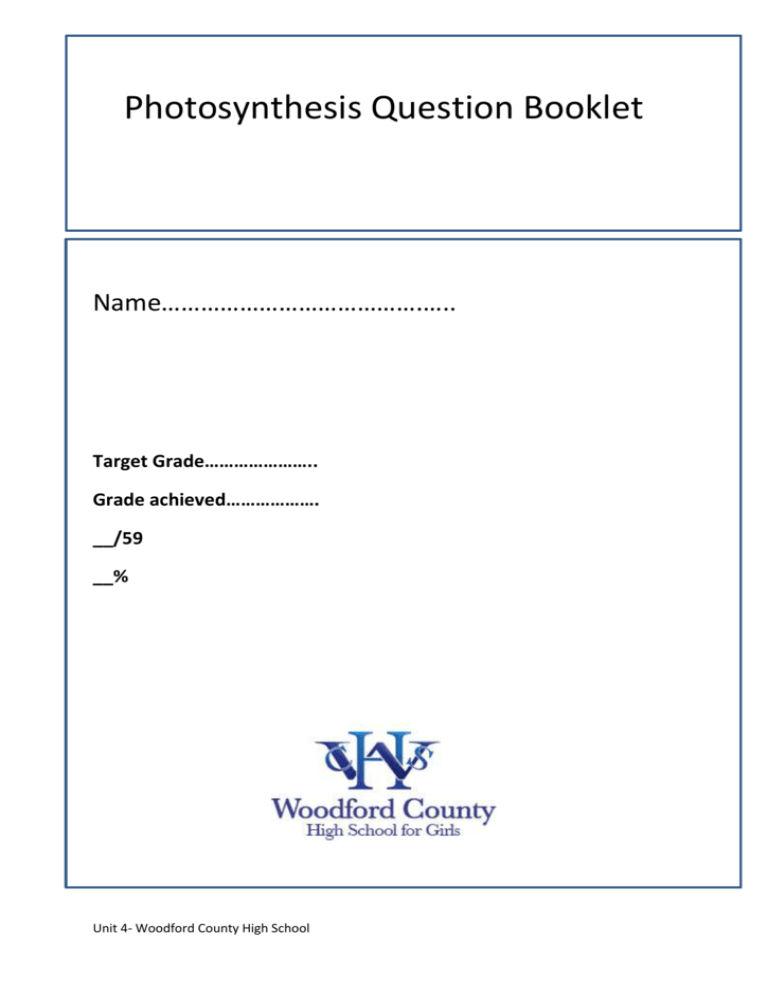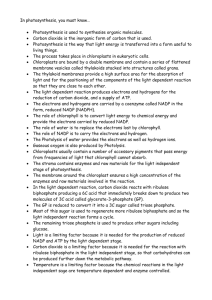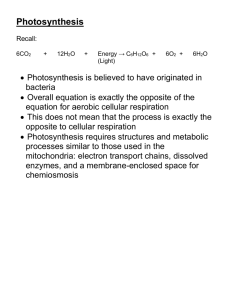Photosynthesis - WordPress.com
advertisement

Photosynthesis Question Booklet Name………………………………….….. Target Grade………………….. Grade achieved………………. __/59 __% Unit 4- Woodford County High School 1. (a) Give two reasons why much of the sunlight falling on the leaves of a plant grown in a glasshouse is not used in photosynthesis. 1.................................................................................................................................. .................................................................................................................................... 2.................................................................................................................................. .................................................................................................................................... (2) (b) What measurements could be taken in order to find the rate of photosynthesis? .................................................................................................................................... .................................................................................................................................... .................................................................................................................................... .................................................................................................................................... (2) (c) Outline how you would investigate the effect of temperature on the yield of a crop of plants grown in a glasshouse. .................................................................................................................................... .................................................................................................................................... .................................................................................................................................... .................................................................................................................................... .................................................................................................................................... .................................................................................................................................... (3) (Total 7 marks) Unit 4- Woodford County High School 2. An investigation was carried out to find out the sequence of biochemical changes that occur during photosynthesis. Radioactive carbon dioxide was added to a suspension of algal cells, and they were allowed to photosynthesise. At intervals, samples of the suspension were removed into hot alcohol. These samples were analysed for different radioactively labelled compounds. Suspension of algal cells Light Syringe for injecting radioactive carbon dioxide Rapid action tap Hot alcohol (a) Explain how the use of radioactive carbon dioxide in this investigation allows the sequence of biochemical changes in photosynthesis to be followed. ..................................................................................................................................... ..................................................................................................................................... ..................................................................................................................................... (2) (b) Suggest a reason for the use in this investigation of (i) hot alcohol; .......................................................................................................................... .......................................................................................................................... (1) Unit 4- Woodford County High School (ii) a rapid action tap. .......................................................................................................................... .......................................................................................................................... (1) Samples were removed from the suspension at five different times, between 5 seconds and 600 seconds after the start of the experiment. In each sample, the radioactivity in four different organic compounds, P, Q, R and S, was measured. The table shows the results. (c) Amount of radioactivity present / arbitrary units Organic compound 5s 15 s 60 s 180 s 600 s P 0.01 0.02 0.08 0.17 0.67 Q 1.00 2.00 3.10 3.15 3.15 R 0.10 1.50 2.20 2.30 2.40 S 0.05 0.11 0.16 1.00 1.00 Use this information to place the compounds P, Q, R and S, in the order in which they were formed in photosynthesis. _____________ _____________ _____________ _____________ (1) (d) Using your knowledge of the light-independent reaction, explain why the level of radioactivity in compound Q remained steady after 180 seconds. ..................................................................................................................................... ..................................................................................................................................... ..................................................................................................................................... ..................................................................................................................................... (2) (Total 7 marks) Unit 4- Woodford County High School 3. The diagram shows a cell organelle. (a) Identify the parts labelled X and Y. X ................................................................................................................................ Y ................................................................................................................................ (2) Light was shone on a suspension of these organelles while it was kept in an atmosphere of pure nitrogen. During this time the organelles made large amounts of two different substances, and gave off oxygen. (b) Name the two substances that were made when the organelles were illuminated. 1 .................................................................................................................................. 2 .................................................................................................................................. (2) The membranes around the outside of the organelles were then broken, and the parts labelled X and Y were separated from each other. In the dark, part Y was supplied with a substance, which it converted into a carbohydrate. (c) What is the name of the substance which was converted into a carbohydrate? .................................................................................................................................... (1) (d) (i) Name the part of the organelle where the enzymes of the light-independent reaction are located. .......................................................................................................................... (1) (ii) Use the diagram to give the function of one other enzyme that is present in this part of the organelle. .......................................................................................................................... (1) (Total 7 marks) Unit 4- Woodford County High School 4. The percentage of light absorbed by an aquatic plant was measured when it was exposed to different wavelengths. The rate of photosynthesis was also measured at each wavelength of light. The results are shown in the graph. Percentage of light absorbed ( ) 400 (a) Rate of photosynthesis ( ) 500 600 Wavelength of light / nm 700 Describe and explain the relationship between light absorption and the rate of photosynthesis for the wavelengths of light between 410 nm and 500 nm. ..................................................................................................................................... ..................................................................................................................................... ..................................................................................................................................... ..................................................................................................................................... (2) Unit 4- Woodford County High School (b) Give one dependent variable you could measure in order to determine the rate of photosynthesis in an aquatic plant. ..................................................................................................................................... (1) (c) Use the graph to identify the range of wavelengths of light that would be green in colour. Give a reason for your answer. Wavelengths ................... to ................... nm Reason ........................................................................................................................ ..................................................................................................................................... (2) (d) A suspension of chloroplasts was isolated from an aquatic plant and a reagent was added. The reagent is blue when oxidised and is colourless when reduced. (i) The suspension of chloroplasts in blue reagent was exposed to sunlight. The blue colour disappeared. Use your knowledge of the light-dependent reactions of photosynthesis to explain why. .......................................................................................................................... .......................................................................................................................... .......................................................................................................................... .......................................................................................................................... (2) (ii) Another suspension of chloroplasts was set up as before. Small quantities of ADP and phosphate ions were added and then the tube was exposed to light. The blue colour disappeared more quickly. Explain why. .......................................................................................................................... .......................................................................................................................... .......................................................................................................................... ......................................................................................................................... (2) (Total 9 marks) Unit 4- Woodford County High School 5. The diagram shows a summary of the light-independent reaction of photosynthesis. Carbon dioxide 1C + Ribulose bisposphate (RuBP) ...... C 2× Glycerate 3-phosphate (GP) ...... C Reduced NADP ATP Triose phosphate (a carbohydrate) ...... C Glucose ...... C (a) (i) Complete the boxes to show the number of carbon atoms in the molecules. (2) (ii) In which part of a chloroplast does the light-independent reaction occur? ......................................................................................................................… . (1) (iii) Which process is the source of the ATP used in the conversion of glycerate 3-phosphate (GP) to triose phosphate? ......................................................................................................................… . (1) (iv) What proportion of triose phosphate molecules is converted to ribulose bisphosphate (RuBP)? ......................................................................................................................… . (1) (b) Lowering the temperature has very little effect on the light-dependent reaction, but it slows down the light-independent reaction. Explain why the light-independent reaction slows down at low temperatures. ..................................................................................................................................... ..................................................................................................................................... Unit 4- Woodford County High School ..................................................................................................................................... ..................................................................................................................................... (2) (Total 7 marks) 6. The graph shows the absorption of different wavelengths of light by three photosynthetic pigments in a red seaweed. Violet Blue Green Yellow Orange Red Chlorophyll a Phycocyanin Phycoerythrin Absorbance 400 (a) (i) 600 500 Wavelength / nm 700 Describe what the graph shows about the properties of chlorophyll a. .......................................................................................................................... (1) (ii) Describe the part played by chlorophyll in photosynthesis. .......................................................................................................................... .......................................................................................................................... .......................................................................................................................... .......................................................................................................................... .......................................................................................................................... (3) Unit 4- Woodford County High School (b) The red seaweed lives under water at a depth of 2 metres. Suggest an advantage to the red seaweed of having other pigments in addition to chlorophyll a. ..................................................................................................................................... ..................................................................................................................................... ..................................................................................................................................... ..................................................................................................................................... (2) (Total 6 marks) 7. (a) Describe how NADP is reduced in the light-dependent reaction of photosynthesis. ..................................................................................................................................... ..................................................................................................................................... ..................................................................................................................................... ..................................................................................................................................... (2) (b) In an investigation of the light-independent reaction, the amounts of glycerate 3-phosphate (GP) and ribulose bisphosphate (RuBP) in photosynthesising cells were measured under different environmental conditions. Figure 1 shows the effect of reducing the carbon dioxide concentration on the amounts of glycerate 3-phosphate and ribulose bisphosphate in photosynthesising cells. Figure 1 1.0 % CO2 0.003 % CO 2 2.5 RuBP 2.0 Relative amounts 1.5 GP 1.0 0.5 0.0 Time Unit 4- Woodford County High School (i) Explain why there is twice the amount of glycerate 3-phosphate as ribulose bisphosphate when the carbon dioxide concentration is high. .......................................................................................................................... .......................................................................................................................... (1) (ii) Explain the rise in the amount of ribulose bisphosphate after the carbon dioxide concentration is reduced. .......................................................................................................................... .......................................................................................................................... (1) (c) Figure 2 shows the results of an experiment in which photosynthesising cells were kept in the light and then in darkness. Figure 2 Light Dark GP Amounts of each radioactive substance Glucose RuBP Application of 14CO2 (i) Light switched off Time In the experiment the cells were supplied with radioactively labelled 14CO2. Explain why the carbon dioxide used was radioactively labelled. .......................................................................................................................... .......................................................................................................................... (1) (ii) Explain how lack of light caused the amount of radioactively labelled glycerate 3-phosphate to rise. .......................................................................................................................... Unit 4- Woodford County High School .......................................................................................................................... .......................................................................................................................... .......................................................................................................................... (2) (iii) Explain what caused the amount of radioactively labelled glucose to decrease after the light was switched off. .......................................................................................................................... . (1) (Total 8 marks) 8. (a) The process of photosynthesis can be subdivided into two stages, one dependent on light, the other independent of light. (i) Complete the table to show the substances used in and the end products of each of these stages. (Do not include solar energy.) Light dependent stage Substances used 1. Water 2. Inorganic phosphate 3. ADP 4. NADP Light independent stage 1. Reduced NADP 2. ATP 3. ...................................... 4. ....................................... End products 1.ATP 2. .................................... 3. .................................... 1. NADP 2. ADP 3. Inorganic phosphate 4. Carbohydrate (2) (ii) What are the functions of reduced NADP and ATP in the light independent stage of photosynthesis? Reduced NADP.................................................................................................. .......................................................................................................................... ATP................................................................................................................... .......................................................................................................................... (2) Unit 4- Woodford County High School (b) The graph shows the effect of temperature on the rate of photosynthesis Rate of photosynthesis X (i) Y Z Temperature /ºC Explain why increasing the temperature from X° C to Y° C increases the rate of photosynthesis. .......................................................................................................................... .......................................................................................................................... .......................................................................................................................... .......................................................................................................................... (2) (ii) Explain why increasing the temperature from Y° C to Z° C decreases the rate of photosynthesis. .......................................................................................................................... .......................................................................................................................... .......................................................................................................................... .......................................................................................................................... . (2) (Total 8 marks) Unit 4- Woodford County High School Mark Scheme 1. (a) (b) (c) wrong wavelength; reflected; miss chloroplast / chlorophyll; (carbon dioxide concentration) another factor may be limiting; 2 oxygen produced / carbon dioxide used; per unit time; 2 description of how temperature is changed / range of temperatures used; how other factors kept the same / named factors controlled; measure mass of given product in given time; 3 [7] 2. (a) (b) (Radioactive) carbon dioxide is used / incorporated; New compound(s) / intermediate(s) / names egs formed / become labelled; (i) (ii) 2 Because stops reaction(s)/ process / pathway / enzyme action / kills algal cells; 1 Because reactions occur quickly OR need to remove samples after short / precise time; 1 R S (c) Q P ; 1 (d) Idea of cycle (or equivalent); Compound Q is used / reformed; If either above present allow identification of possible Q as: G3P / PGA / triose phosphate / GALP / RuBP Any two from three (noting special arrangement re. third point) 2 [7] 3. (a) (b) X = grana/lamellae/thylakoid (membranes); Y = stroma; 2 NADPH2/ NADPH/ reduced NADP/reduced coenzyme; ATP; 2 (c) carbon dioxide/CO2; (d) (i) stroma; NOT “Y” Unit 4- Woodford County High School 1 1 (ii) production/breakdown of starch (or equivalent); 1 [7] 4. (a) (b) (c) (d) the more light absorbed, the greater the rate of photosynthesis; light provides the energy for light dependent reactions / photolysis / light independent reactions / production of reduced NADP / exciting electrons in chlorophyll; (do not give credit if energy is used in photosynthesis) 2 count the number of bubbles / measure the volume of gas / measure the change in pH / carbon dioxide / hydrogen carbonate ions; (credit oxygen produced) 1 530 – 630 nm; (any values within this range) limited absorption of light / (green) plants reflect green light / limited photosynthesis at these wavelengths of light; (allow references to no light absorbed or no photosynthesis) (i) (ii) chlorophyll excited / reduced NADP formed; electrons from chlorophyll / reduced NADP changes the dye colour; ADP and phosphate needed to produce ATP / ATP is a product of the light dependent reactions; ADP levels are a limiting factor; (must explain the idea of limiting factors – do not credit answers like more ADP causes more photosynthesis) 2 2 2 [9] 5. (a) RuBP – 5; GP – 3; TP – 3; Glucose – 6; (all correct = 2 marks; 3 or 2 correct = 1 mark) 2 (ii) stroma; 1 (iii) light-dependent reaction / (photo)phosphorylation; (accept photolysis) 1 5 out of 6 / 83% / equivalent; 1 (i) (iv) (b) enzymes involved / not a photochemical reaction; slow rate of enzyme/chemical reaction at low temperature / less kinetic energy / fewer collisions; 2 [7] 6. (a) (i) pigment reflects/does not absorb green or yellow or orange; pigment absorbs blue or violet; pigment absorbs red; (accept correct wavelengths instead of colours) Unit 4- Woodford County High School 1 (any 2 for 1 mark) (ii) (b) light (energy) absorbed by chlorophyll; raises energy level of electrons / electrons are excited/emitted; ATP formed; 3 more wavelengths / colours absorbed; more (efficient) photosynthesis can occur at these depths / low light intensities or more (efficient) photosynthesis can occur when some wavelengths are not present; 2 [6] 7. (a) (b) (c) electrons; from chlorophyll / photolysis; 2 (i) RuBP combines with carbon dioxide to produce 2 x GP; 1 (ii) less used to combine with carbon dioxide / less used to form glycerate 3-phosphate; 1 (i) used in photosynthesis allows detection of products; 1 (ii) ATP and reduced NADP not formed; GP is not being used to form RuBP / is being formed from RuBP; 2 used in respiration / formation of starch / cellulose; 1 (iii) [8] 8. (a) (i) 2 Light dependent stage Raw materials End products (ii) (b) (i) (ii) Light independent stage Carbon dioxide and ribulose bisphosphate/ RuBP; Reduced NADP and oxygen; reduced NADP provides the hydrogen to change GP to TP/reduces GP; ATP provides the energy to resynthesise ribulose bisphosphate/ change / reduce GP /synthesise hexose; 2 kinetic effect / molecules move faster / more kinetic energy; more collisions; more enzyme -substrate complex formed / more binding to active site; max. 2 breaking of (correct) bonds in enzyme molecule; shape of active site changed / denaturation; substrate does not bind / attach to enzyme; max. 2 [8] Unit 4- Woodford County High School






